Martin (US) not mentioned
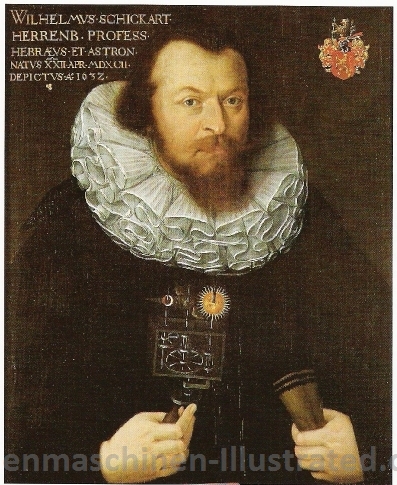
Wilhelm Schickard (1592 - 1635) studied theology and oriental languages. In 1613 he became a Lutheran minister, 1619 professor of Hebrew at the university of Tübingen. In 1631 he was appointed professor of astronomy. His research included astronomy, mathematics and surveying. He invented many machines like one to calculate astronomical dates; he also made significant advances in mapmaking.
Schickard invented a calculating machine in 1623. The drawings of this machine were found in his letters to Kepler. The machine Schicard originally built for Kepler burned in a fire. Schickard, most likely, has never built another machine for Keppler. In "History of Computing Technology" Michael R. Williams wrote that the machine's major drawback was a too simple carry mechanism. Although it was a first workable mechanical adding machine, the machine was impractical if the number of digits was bigger than 6.
There is no machine built by Schickard left and the plans and details were not (re)discovered until 1957. A number of replicas have been build since then.
The machine incorporates a set of "Napier's bones" (on the cylinders) and rings to remember a carry propagated from the end of accumulator
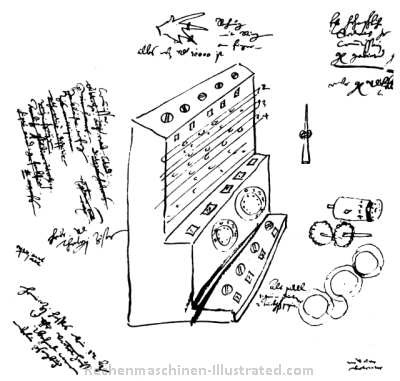
| principle | combination of Napier's bones and a add/sub engine |
replica |
|
| capacity | |||
| production years | 1623 - | ||
| machines built | few | ||
| features | |||
| for bigger and more pictures, click on the picture |
source: F.Haeghens
Martin (Dtsch), pages 35 - 41
Blaise Pascal (1623 - 1662) is one of the most important French philosophers.
Pascal was a child prodigy, who was educated by his father. He was a mathematical genius. At 16 he wrote the Essai pour les coniques which was published in 1640. In 1642 he invented a calculating machine to help his father, who served as Royal Tax Commissioner at Rouen. Pascal is often credited with the discovery of the mathematical theory of probability, and he also made serious contributions to number theory and geometry.
Between 1642 and 1652 around 50 Pascaline's were manufactured, 8 or 9 survived:
1 or 2 are in the IBM collection; 4 at the Musée des arts et métiers (CNAM, Paris); 2 at the Musee du Ranquet (Clermont-Ferrand) and one at the Staatliche Kunstsammlungen Dresden, Mathematisch-Physikalischer Salon.
For a more detailed biography of Pascal see the web-site of the St. Andrews University or from the book A Short Account of the History of Mathematics by W. W. Rouse Ball at the web site of the Trinity College, Dublin
Additional resources:
Yves Serra's site with details of the pascaline
The History of Computing Project: http://www.thocp.net/hardware/pascaline.htm
| principle |
replica |
||
| capacity | 8 x x 8 | ||
| production years | 1642 - | ||
| machines built | ca. 50 | ||
| features | add and subtract | ||
| for bigger and more pictures, click on the picture |
source: V.Monnier
Sam Morland (1666)
Martin (Dtsch), page 41
"Morland constructed an adding machine that can at best be regarded as an improvement of Pascal's machine and also a multiplication machine based upon the principle of Napier's calculating rods. "
| principle | |||
| capacity | |||
| production years | 1666 - ??? | ||
| machines built | |||
| features | add and subtract | ||
| no tenth carriage | |||
| for bigger and more pictures, click on the picture | |||
| by permission of the Museum of the History of Science, University of Oxford inventory no: 55139 |
"Samuel Morland's calculator (1664). The machine consists of a gilt brass plate carrying 55 numbered silver circles and 17 numbered silvered brass circles. It is housed in a wooden case with a crystal lid. It seems that the design was inspired by Napier's rods. The rods are inscribed on brass circles and these can be turned, via a crank, to show the products through a series of window-like displays"
from: N.Baaijens
| principle | based on Napier's rods | ||
| capacity | |||
| production years | |||
| machines built | |||
| features | |||
| for bigger and more pictures, click on the picture | |||
| source: N.Baaijens |
| principle | |||
| capacity | |||
| production years | |||
| machines built | |||
| features | |||
| for bigger and more pictures, click on the picture | |||
| source: library of congress LC-USZ62-110470 |
Martin (Dtsch), page 41 - 45
Indignum enim est excellentiurn virorum horas servili calculandi labore perire,
qui machina adhibita vilissimo cuique secure transcribi posset.
It is beneath the dignity of excellent men to waste their time in calculation when any
peasant could do the work just as accurately with the aid of a machine.
-Leibniz
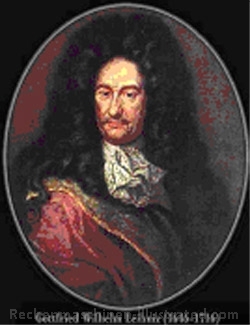
"In 1672 the famous mathematician and philosopher Gottfried Wilhelm Leibniz began to occupy himself with the design and construction of a machine for the four fundamental operations of arithmetic."
Literature:
K.Badur und W.Rottstedt: Erfahrungen beim Nachbau einer Leibniz-Rechenmaschine: Und sie rechnet doch richtig, in: Historische Bürowelt, 74 (2006), pages 13 - 16 (IFHB)
![]() (1.8 MB)
(1.8 MB)
| principle | stepped drum | ||
| capacity | 8 x 1 x 16 | ||
| production years | 1672 | ||
| machines built | 3 | ||
| features | |||
| for bigger and more pictures, click on the picture |
Martin (Dtsch), page 46
"This is an adding machine similar to Pascal’s machine. It has three rows of seven dials, the rows lying below one another. Numbers are set on the dial by turning them with a stylus. The machine possesses no control mechanism, thus it has no need of any device, such as a crank, wheel, or band to power it. It is described in the Journal des Scavuns, (1678)."
Literature: J.Marguin, Histoire des instruments et machines à calculer, Paris, page 75
| principle | Napier drums plus disk adder | ||
| capacity |
|
||
| input | |||
| prod. years | 1675 | ||
| mach. built | |||
| features | |||
| dimensions | |||
| weight | |||
| known s/n | |||
| for bigger and more pictures, click on the picture | |||
| source: Musée des arts et métiers (CNAM, Paris), photo:W,Szrek |
Abaque Rhabdologique
tooth rack adder from C.Perrault, similar to Landin and Comptator
Literature: The Abaque Rhabdologique of Claude Perrault
note: the description and pictures are from:
published in Paris, 1735 and 1765
| principle | tooth rack adder | ||
| capacity |
|
||
| input | |||
| prod. years | 1700 | ||
| mach. built | |||
| features | |||
| dimensions | |||
| weight | |||
| known s/n | |||
| for bigger and more pictures, click on the picture | |||
| source: Musée des arts et métiers (CNAM, Paris) |
Additionneur de Caze
This device is directly derived from abacus. Little balls are replaced by moving rods which are shifted up to add or down to subtract with the help of a stylus. Carry is not automated: this is not a machine.
Literature: J.Marguin, Histoire des instruments et machines à calculer, Paris, page 27
| principle | |||
| capacity |
|
||
| input | |||
| prod. years | 1720 | ||
| mach. built | |||
| features | |||
| dimensions | |||
| weight | |||
| known s/n | |||
| for bigger and more pictures, click on the picture | |||
| source: Musée des arts et métiers (CNAM, Paris), photo:W,Szrek |
Martin (Dtsch), page 48
"This is an adding machine without keys, essentially a simplified version of Pascal's machine."
note: the description and pictures are from:
published in Paris, 1735 and 1765
| principle | |||
| capacity |
|
||
| input | |||
| prod. years | 1725 | ||
| mach. built | |||
| features | |||
| dimensions | |||
| weight | |||
| known s/n | |||
| for bigger and more pictures, click on the picture | |||
| source: W.Szrek |
Martin (Dtsch), page 48
"In the Theatrum Arithmetico Geometricum, Jacob Leupold published the drawing of a calculating machine shown in figure 21, but it was never constructed."
In the literature is the statement, that the above words of Martin are wrong, i.e. at least one Leupold machine was constructed. However, if so, this machine didn't survive.
see also Braun.
Literature:
R.Paland: Die Leupold-Maschine, Historische Bürowelt 8, page 14-15 (1985) , IFHB
E.Anthes: Die zylindrischen Rechenmaschinen von Leupold bis Herzstark, Historische Bürowelt 22, page 16-21 (1988) , IFHB
| principle | ratchet (geared wheel) | ||
| capacity | |||
| production years | ca. 1727 | ||
| machines built | 1 (?) | ||
| features | |||
| for bigger and more pictures, click on the picture |
source: Theatrum Arithmetico Geometricum
Anton Braun (1686 - 1728) is associated with two calculation machines:
- a pin wheel machine finished 1727 with similarities with the Poleni machine. This machine today is in Vienna.
- a ratchet based machine almost identical to the Leupold machine, finished 1736, i.e. after Braun's death. The inscription "Braun invenit, Vayringae fecit" is today interpreted in a way, that Braun designed the machine and Phillippe Vayringe (1684 - 1746) actually constructed it. The machine is in the Deutsches Museum, Munich.
Literature:
E.Anthes: Zum 300. Geburtstag von Anton Braun, Historische Bürowelt 18, page 23-27 (1987) , IFHB
E.Anthes: Die zylindrischen Rechenmaschinen von Leupold bis Herzstark, Historische Bürowelt 22, page 16-21 (1988) , IFHB
| principle | pin wheel | ||
| capacity | 7 x 1 x 11 |
||
| input | key | ||
| prod. years | 1727 | ||
| mach. built | 1 | ||
| features | |||
| dimensions | |||
| weight | |||
| known s/n | |||
| for bigger and more pictures, click on the picture | |||
| source: Techn.Museum Wien; photo: W.Szrek |
| principle | ratchet (geared wheel) | ||
| capacity |
|
||
| input | key | ||
| prod. years | 1736 | ||
| mach. built | 1 | ||
| features | |||
| dimensions | |||
| weight | |||
| known s/n | |||
| for bigger and more pictures, click on the picture | |||
| source: Deutsches Museum, München; photo: W.Szrek |
Hillerin de Boistissandeau (1730)
Martin (Dtsch), page 48
"This is an adding machine, without key setting, similar in type to that produced by Pascal. The friction generated during the use of this machine was so great that it could not be used in practice. The inventor attempted to improve it twice, but without success."
note: the description and pictures are from:
published in Paris, 1735 and 1765
| principle | |||
| capacity |
|
||
| input | |||
| prod. years | 1730 | ||
| mach. built | |||
| features | |||
| dimensions | |||
| weight | |||
| known s/n | |||
| for bigger and more pictures, click on the picture | |||
| source: W.Szrek |
Martin (Dtsch), page 48
"In 1735, C. L. Gersten, mathematics professor in Giessen, submitted to the Royal Society in London an adding and subtracting machine with setting slides that had six places in the setting mechanism and seven places in the result mechanism and that also had a tens-carry mechanism. A model of the machine can be found in the Calculating Machine Museum of the firm Grimme, Natalis and Company in Braunschweig."
The only known machine in Darmstadt was lost 1943 during World-War II. Under the direction of F.Trinks from Grimme, Natalis & Company, a replica was build in 1920 for the company's own museum of historical calculation machines. This replica is now the only known Gersten machine. (now in the Landesmuseum Braunschweig)
R. Paland from the Braunschweigisches Landesmuseum describes the background and technical details of the Gersten machine in "Historische Bürowelt, No.13, pages 15-16, April 1986" (IFHB).
| principle | |||
| capacity | 6 x x 7 | ||
| production years | 1735 | ||
| machines built | 1 (?) | ||
| features | add and subtract | ||
| for bigger and more pictures, click on the picture |
source: IFHB
Jakobson (1770) (Jacobson)
Hebreer Jewna Jakobson, watchmaker and mechanic, Nieswiez (Polish-Lithuanian Commonwealth, Russia, Poland, Soviet Union, Belarus, in chronological order)
History of Computers and Computing: The Mechanical Calculating Machine of Jewna Jacobson
| principle | disk adder | ||
| capacity |
|
||
| input | |||
| prod. years | 1770 | ||
| mach. built | |||
| features | |||
| dimensions | 34 x 22 x 4 cm | ||
| weight | |||
| known s/n | |||
| for bigger and more pictures, click on the picture | |||
| source: Peter the Great Museum of Anthropology and Ethnography, St.Petersburg, Coll. No ML-00469 |
Martin (Dtsch), page 49 - 55
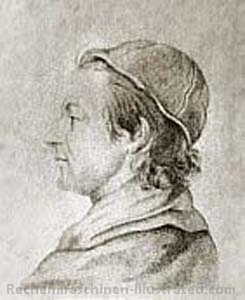
"The Parson Phillip Matthäus Hahn was born on 25 November 1739, at Scharnhausen. He was not only a parson but an eminent clockmaker and maker of astronomical instruments as well. He also undertook, from 1770 in Kornwestheim and from 1781 in Echterdingen, the manufacture of calculating machines. According to the present status of research in calculating machines, he was the first to design a truly usable calculating machine for all four arithmetic operations and to manufacture a number of models, several of which have been preserved and are still in usable condition."
"It has not been established how many copies of this machine were produced. According to Engelmann there are four in Stuttgart, there is one in the Deutsches Museum in Munich (which also has two copies by his brother-in-law, Johann Christopher Schuster), one is owned by the Duke of Urach, one is in the Technische Hochschule in Charlottenburg (likewise by Schuster). Since Hahn’s two sons in Stuttgart and his brother-in-law Schuster in Uffenheim and Ansbach manufactured calculating machines after Hahn’s death (Schuster, in fact, up to 1820). it is likely that an appreciable quantity were produced having various numbers of decimal places."
see also: E.Anthes, Die zylindrischen Rechenmaschinen von Leupold bis Herzstark, Historische Bürowelt, Ausgabe 22, page 16ff, 7/1988 (IFHB)
| principle | stepped drum | ||
| capacity | 11 x 11 x 11 | ||
| production years | 1770 - 1777 | ||
| machines built | 5 (?) | ||
| features |
add and multiply (subtract/divide by complement) |
||
| for bigger and more pictures, click on the picture |
source: Württembergisches Landesmuseum Stuttgart (Frankenstein/Zwietasch)
| principle | Napier's bones | ||
| capacity | 8 | ||
| production years | around 1780 | ||
| machines built | |||
| features |
|
||
| for bigger and more pictures, click on the picture |
source: Württembergisches Landesmuseum Stuttgart
Johann Christoph Schuster, brother-in-law of Hahn
Literature:
Bernhard Korte: Die Rechenmaschine von Johann Christoph Schuster 1820/22. Patrimonia 203, KulturStiftung der Länder und Arithmeum, Bonn 2004
Bernhard Korte: The Mechanical Calculating Machine of Johann Christoph Schuster 1820/22. Patrimonia 203, KulturStiftung der Länder und Arithmeum, Bonn 2004.
Description and pictures of all known Hahn and Schuster calculators
| principle | stepped drum | ||
| capacity | 12 |
||
| input | key | ||
| prod. years | 1792 | ||
| mach. built | |||
| features | |||
| dimensions | |||
| weight | |||
| known s/n | |||
| for bigger and more pictures, click on the picture | |||
| source: Deutsches Museum, München; photo: W.Szrek |
| principle | stepped drum | ||
| capacity | 9 |
||
| input | |||
| prod. years | 1820 | ||
| mach. built | |||
| features | |||
| dimensions | |||
| weight | |||
| known s/n | |||
| for bigger and more pictures, click on the picture | |||
| source: Deutsches Museum, München; photo: W.Szrek |
Martin (Dtsch), page 55
"Lord Mahon, Earl of Stanhope, designed two machines, one for addition and subtraction and the other one for multiplication and division. His constructions are also reported to exhibit the drums with teeth of uneven length (stepped drums), which were employed by Leibniz and Hahn."
| principle | ??? | ||
| capacity | ??? | ||
| production years | 1775 - ??? | ||
| machines built | ??? | ||
| features | add and subtract |
||
| for bigger and more pictures, click on the picture | |||
|
by permission of the Museum of the History of Science, University of Oxford inventory no: 39261 |
Martin (Dtsch), page 55-56
"Johann Helfreich Müller, a captain in the engineers and county surveyor, designed a calculating machine, which he had built by a clockmaker from Giessen. It is very similar to Hahn’s machine, but Hahn’s setting rods, which were adjustable in height and had to be handled very carefully, were replaced by rotatable disks that bore the digits 0 to 9. A Müller machine may be found in the museum in Darmstadt."
Literature:
E.Anthes: Die zylindrischen Rechenmaschinen von Leupold bis Herzstark, Historische Bürowelt 22, page 16-21 (1988) , IFHB
![]() W.Lange: technical description
of the Müller machine (1981, in German)
W.Lange: technical description
of the Müller machine (1981, in German)
| principle | stepped drum | ||
| capacity |
|
||
| input | |||
| prod. years | 1783 | ||
| mach. built | |||
| features | |||
| dimensions | |||
| weight | |||
| known s/n | |||
| for bigger and more pictures, click on the picture | |||
| source: LM Darmstadt, Foto: E.Anthes |
Martin (Dtsch), page 56
"Jacob Auch, one of Hahn's coliaborators, constructed a machine that can be seen in the Physical Institute of the Technische Hochschule in Karlsruhe. It was rectangular in form and is reported to have been suitable for adding, multiplying, subtracting, and dividing ."
note: the machine is now located in the Württembergisches Landesmuseum Stuttgart.
| principle | ??? | ||
| capacity | 8 | ||
| production years | 1790 | ||
| machines built | |||
| features |
|
||
| for bigger and more pictures, click on the picture |
source: Württembergisches Landesmuseum Stuttgart (Frankenstein/Zwietasch)
Martin (Dtsch), page 57
"The clockmaker Abraham Stern of Warsaw constructed a machine in which it was only necessary to set up the amount to be manipulated and then to start a clockwork mechanism. In 1817 he made a second machine that served mainly for extracting square roots. Later he consolidated the two machines into one, but it never had any real influence on further developments."
Literature:
![]() Max Detlefsen: Polnische
Rechenmaschinenerfinder des 19. Jahrhunderts; Wissenschaft und Fortschritt,
26 (1976), pages 86 - 90
Max Detlefsen: Polnische
Rechenmaschinenerfinder des 19. Jahrhunderts; Wissenschaft und Fortschritt,
26 (1976), pages 86 - 90
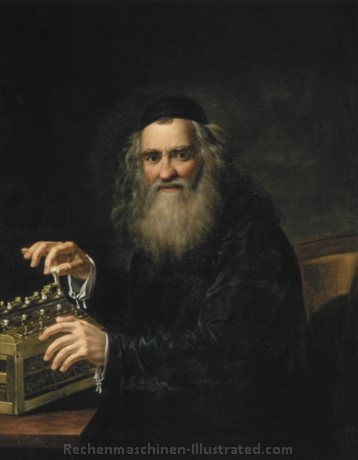
Painting by Antoni Blanck. The partly shown machine is probably an early model for the calculation of the four fundamental rules of arithmetic and not the universal machine from Stern.
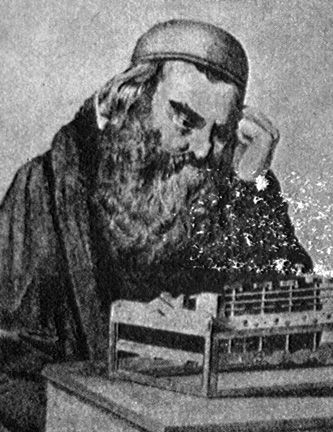
H. Winnicka: Zapomniany wynalazca, PZWS Warszawa 1962
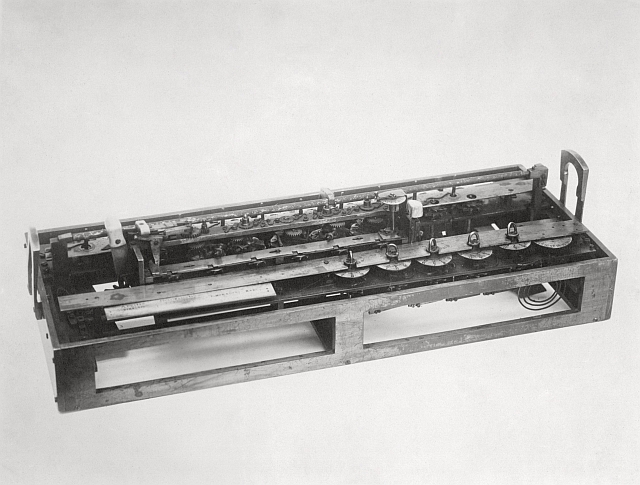
source: Science Museum, London UK; cat.no. 1927-1012 (presented to museum by Mr J A Turck)
last updated: 05-Jun-12